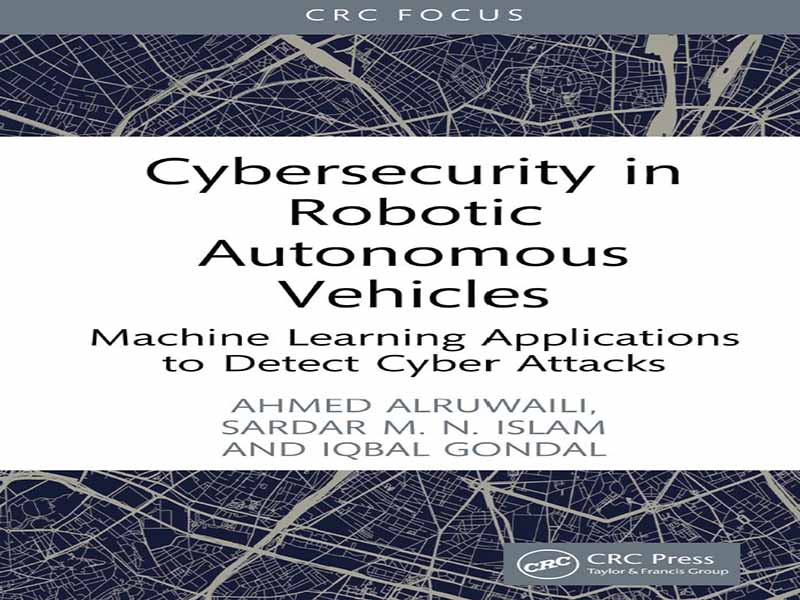- عنوان کتاب: Cybersecurity in Robotic Autonomous Vehicles -Machine Learning Applications to Detect Cyber Attacks
- نویسنده: Ahmed Alruwaili, Sardar M.N. Islam
- حوزه: امنیت سایبری
- سال انتشار: 2025
- تعداد صفحه: 107
- زبان اصلی: انگلیسی
- نوع فایل: pdf
- حجم فایل: 5.23 مگابایت
فناوری در گذشتهی اخیر با سرعت بسیار زیادی توسعه یافته است و این امر تأثیر زیادی بر جامعه در جنبههایی مانند ارتباطات و حمل و نقل داشته است. یکی از نوآورانهترین فناوریها، اینترنت وسایل نقلیه (IoV) است که میتواند دنیای حمل و نقل را تغییر دهد و سیستمی از وسایل نقلیهی خودران و هوشمند متصل به یک شبکهی بههمپیوسته ایجاد کند. با این حال، با افزایش اتصال، یک چالش جدید امنیت سایبری ایجاد میشود که ناشی از این واقعیت است که وسایل نقلیه اکنون در معرض تهدیدات سایبری هستند که میتوانند ایمنی، قابلیت اطمینان و کارایی آنها را تهدید کنند. این چالشها انگیزهی اصلی این کتاب را تشکیل میدهند: نیاز فوری به توسعهی راهحلهای قوی امنیت سایبری برای وسایل نقلیهی خودران (AV) که در اکوسیستم IoV کار میکنند. برخی از مهمترین سیستمهای گذرگاه مورد استفاده در وسایل نقلیهی مدرن، شبکهی ناحیهی کنترلکننده (CAN) هستند. گذرگاه CAN شبکهای است که جریان اطلاعات بین واحدهای کنترل الکترونیکی (ECU) درون وسیلهی نقلیه را کنترل میکند. اگرچه این یک جزء حیاتی در مدیریت عملکرد کلی AVها است، گذرگاه CAN با در نظر گرفتن امنیت توسعه داده نشده است. فقدان مکانیسمهای امنیتی آن، وسایل نقلیه را در معرض آسیبپذیریهای جدی، از جمله حملات تزریق پیام، قرار میدهد. در چنین حملاتی، هکرها میتوانند دستورات مخرب را به گذرگاه CAN تزریق کنند که منجر به انجام اقدامات خاصی توسط ECUها میشود که قرار نیست انجام دهند و ممکن است منجر به نقص عملکرد، تصادف یا حتی تلفات جانی شود. گذرگاه CAN به اولویتبندی پیامها بر اساس شناسههای CAN متکی است. مقادیر پایینتر شناسه CAN برای انتقال در اولویت قرار میگیرند که فرصتی را برای مهاجمان فراهم میکند تا پیامهای با اولویت بالا را دستکاری کرده و عملکرد عادی خودرو را مختل کنند. این امر مستلزم استراتژیهای جدیدی برای مقابله با این تهدید است که با اقدامات امنیتی مرسوم قابل حل نیست. در پاسخ به این چالشها، این کتاب یک سیستم تشخیص نفوذ (IDS) جدید را معرفی میکند که به طور خاص برای AVها طراحی شده است و از اولویتبندی دادهها در شناسههای CAN برای افزایش تشخیص و کاهش تهدید استفاده میکند. به طور دقیقتر، IDS توالی پیامهای گذرگاه CAN را تجزیه و تحلیل کرده و جریان دادهها را فیلتر میکند که این امر کارایی تشخیص ناهنجاری و تهدید سایبری را افزایش میدهد. ما چارچوبهای یادگیری ماشین و یادگیری عمیق را در IDS گنجاندهایم تا ترافیک گذرگاه CAN را تجزیه و تحلیل کرده و وجود هرگونه فعالیت مخرب را در زمان واقعی با سطح بالایی از دقت شناسایی کنیم. با بهکارگیری طبقهبندیکنندههایی مانند ماشینهای بردار پشتیبان (SVM)، k-نزدیکترین همسایهها (KNN) و شبکههای عصبی، این سیستم توانسته است با حداقل هشدارهای کاذب، نرخ دقت بیش از 99٪ را در شناسایی بین دادههای واقعی و تهدیدات احتمالی حفظ کند. این کتاب، بررسی جامعی از خطرات امنیت سایبری که خودروهای خودران با آن مواجه هستند، با تأکید ویژه بر آسیبپذیریهای CAN و استفاده نوآورانه از اولویتبندی دادهها در شناسههای CAN ارائه میدهد. این کتاب با پر کردن شکاف تحقیقاتی بین مطالعات نظری و پیادهسازیهای عملی، روش جدیدی را برای بهبود امنیت خودرو ارائه میدهد. این رویکرد نه تنها برای محققان مفید است، بلکه به متخصصان صنعت نیز روشهای مفیدی را ارائه میدهد که میتوانند برای محافظت از سیستمهای واقعی AV استفاده شوند. خوانندگان، این کتاب را هم به عنوان یک راهنمای مرجع و هم به عنوان یک راهنمای عملی برای بهبود امنیت سایبری خودروهای خودران، بسیار ارزشمند خواهند یافت. محققان میتوانند از مدلها و چارچوبهای ارائه شده در اینجا برای پیشرفت بیشتر در حوزه امنیت سایبری خودرو، بررسی مسیرهای جدید در اولویتبندی دادهها و تشخیص حمله استفاده کنند. این راهکارها میتوانند توسط متخصصان و مهندسان صنعت برای بهبود ایمنی شبکههای خودروهای خودران فعلی و آینده مورد استفاده قرار گیرند و سیستم IDS را برای استفاده در جنبههای مختلف IoV انعطافپذیر سازند.
Technology has developed at a very fast rate in the recent past, and this has greatly impacted society in aspects such as communication and transport. One of the most innovative technologies is the Internet of Vehicles (IoV), which can change the world of transportation and build a system of autonomous and intelligent vehicles connected to an interconnected network. However, with the increased connectivity arises a new cybersecurity challenge that stems from the fact that vehicles are now susceptible to cyber threats that can threaten their safety, reliability, and efficiency. These challenges form the core motivation for this book: the urgent need to develop robust cybersecurity solutions for autonomous vehicles (AVs) operating within the IoV ecosystem. Some of the most critical bus systems used in modern vehicles are the controller area network (CAN). CAN bus is the network which controls the flow of information between the electronic control units (ECUs) within the vehicle. Although it is a crucial component in managing the overall functioning of AVs, the CAN bus was not developed with security as a consideration. Its lack of security mechanisms exposes vehicles to serious vulnerabilities, including message injection attacks. In such attacks, hackers can inject malicious commands into the CAN bus, which leads the ECUs to perform certain actions that they were not supposed to, which may lead to malfunctions, accidents, or even fatalities. CAN bus is its reliance on message prioritisation based on CAN IDs. Lower CAN ID values are prioritised for transmission, which presents an opportunity for attackers to manipulate high-priority messages and disrupt the normal functioning of the vehicle. This calls for new strategies to address this threat that cannot be solved by conventional security measures. In response to these challenges, this book introduces a novel intrusion detection system (IDS) specifically designed for AVs, which leverages data prioritisation in CAN IDs to enhance threat detection and mitigation. To be more precise, the IDS analyses the sequence of CAN bus messages and filters the data flow, which increases the efficiency of anomaly and cyber threat detection. We have incorporated machine learning and deep learning frameworks into the IDS in order to analyse CAN bus traffic and identify the presence of any malicious activities in real time with a high level of accuracy. By employing classifiers like support vector machines (SVM), k-nearest neighbours (KNN), and neural networks, the system has been able to maintain an accuracy rate of more than 99% in identifying between the genuine data and the possible threats with minimal false alarms. This book provides a comprehensive examination of the cybersecurity risks faced by AVs, with a particular emphasis on CAN vulnerabilities and the innovative use of data prioritisation within CAN IDs. Through filling the research gap between the theoretical studies and practical implementations, it offers a new method for improving vehicle security. This approach is not only beneficial for researchers but also offers industry professionals helpful meth¬ods that can be used to protect actual AV systems. Readers will find this book invaluable as both a reference guide and a practical manual for improving the cybersecurity of autonomous vehicles. Researchers can use the models and frameworks presented here to further advance the field of vehicular cybersecu¬rity, exploring new directions in data prioritisation and attack detection. These solutions can be used by industry professionals and engineers to improve the safety of current and future autonomous vehicle networks, making the IDS system flexible for use in various aspects of the IoV.
این کتاب را میتوانید از لینک زیر بصورت رایگان دانلود کنید:




































نظرات کاربران